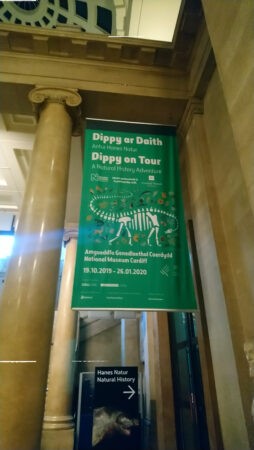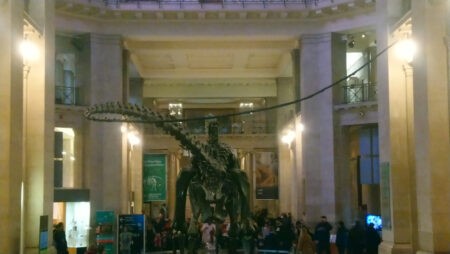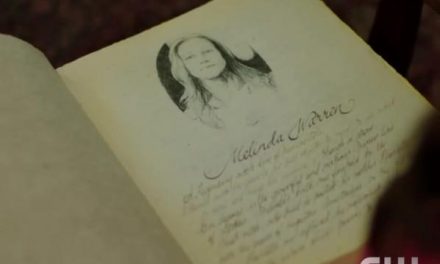The topic of this blog, which concerns mediations of a particular species of dinosaur across factual television, museum and visitor reception contexts, might seem a little distant from current debates that are taking place within television studies. As disciplinary developments have taken what I refer to as a ‘technological’ or ‘algorithmic’ turn, where important questions regarding the distinct formal properties of television-as-medium within an era of streaming platforms and digital distribution have been foregrounded, such lines of inquiry have nevertheless moved away from my own areas of academic interest in television. That is, while a host of excellent publications have grappled with what constitutes ‘television’ in the current historical moment, one consequence has been that textual analysis of ‘television’s texts’ and (some, not all) of the contexts that enable these, have waned.
Another reason for my distance from the current centre of television studies is due to my undertaking of an ongoing research project concerning representations and meanings of the Mesozoic period and its associated prehistoric inhabitants across multiple popular mediations. Although part of this research involves the continuing analysis of televisual texts, a major component of the project has involved ethnographic field work observing how visitors to the National Museum, Cardiff consumed and engaged with the ‘Dippy on Tour’ exhibit during its stay between 19th October 2019 and 26th February 2020. Grappling with this data, and how it resonates with televisual mediations of dinosaurs in factual programmes, is the focus of this blog.
For those unfamiliar with ‘Dippy on Tour’, this is a campaign instigated by the National History Museum, London (NMH hereafter) that has seen the cast skeleton of diplodocus carnegeii, popularly known as ‘Dippy’, go on loan to various cities around the United Kingdom. Before the tour began, Dippy had been the central attraction of the NMH’s main Hintze Hall (where the public enters the museum) from 1979 to 2017. Dippy has, for many years, been a major factor in how the NHM has marketed itself as a tourist attraction.
It was with great pleasure, that January of this year saw Channel 5, the UK’s youngest broadcast channel, which is now owned by Viacom, transmit the four-part documentary series Natural History Museum: World of Wonder (The Garden 2021). Especially noteworthy was the second episode as this explicitly featured Dippy by way of a short narrative involving the NHM’s Head of Conservation, Lorraine Cornish, visiting the exhibit in Rochdale, Lancashire to check on its condition.
The ‘visiting Dippy’ sequence reaffirms popular meanings concerning the perceived appeal of dinosaurs to the public. For example, the sequence’s visual discourse, articulated through shot selection and camera movement, frequently highlights the size of the Dippy exhibit to viewers through either long shots that position the skeleton extending from the foreground into the background, single-take tracking shots that move alongside the exhibit, or of (presumably socially bubbled) visitors observing Dippy from an elevated perspective. The emphasis on Dippy’s size is further connoted by the sequence’s narration where it is noted that Dippy has ‘squeezed in to’ the ‘huge’ public library in Rochdale.
These choices support W.J.T Mitchell’s (1998: 19) argument that part of the enduring appeal of the dinosaur as a cultural artefact is that “it is large, fierce, and extinct”. Expanding this point, Jose Luis Sanz (2002: 47) argues that “a brachiosaur or a tyrannosaur can cause a feeling of uneasiness in human beings, who are fascinated by their potential for power and domination.” In other words, dinosaurs dislodge humanity’s unquestioned status as the Earth’s dominant species at present by highlighting how, in previous geological eras, this was not the case. Although Dippy’s status as a sauropod herbivore renders them ‘safer’ than other popular dinosaur species such as T-rex, the aesthetics of this sequence reinforce Dippy’s, and dinosaurs’ more generally, cultural status as a spectacle with the ability to simultaneously inspire both awe and fear.
My own observations of how visitors to National Museum, Cardiff engaged with the Dippy exhibit demonstrated similar reactions to those encouraged by the documentary. Most visitors attempted to take at least one photograph of the exhibit, often searching for the best place to stand whilst struggling to get the full length of the exhibit into the frame. These struggles involved the use of multiple forms of photographic devices ranging from smart phones and tablets through to semi-professional SLRs. What’s more, and like the visitors seen in the documentary sequence, individual and/or groups of visitors frequently moved up to the museum’s first floor where more complete views of the exhibit could be obtained by looking down on the National Museum’s main hall from an elevated position. These visitors – whether in the documentary or at the National Museum, Cardiff – implied that adopting a detached and observant ‘scientific gaze’ (see Foucault 2003 [1989]) was the most appropriate way to consume the Dippy exhibit.
However, due in part to the size of the Dippy skeleton, most visitors that I observed also toured around the exhibit on the ground level with many finding an additional point of fascination in the staging of Dippy’s tail. This interest in the tail was also suggested by the sequence in Natural History Museum: World of Wonder as on two separate occasions, shots of visitors pausing to look at and appreciate the exhibit’s tail were included.
Rather than simply extending outwards to demonstrate the diplodocus’s full length, Dippy’s tail is instead posed in a curling manner that suggested whip-like movement and dynamism to this part of the creature’s anatomy. As scholars and popular sources alike have therefore implied, the choices made for posing an individual dinosaur skeleton represent an additional layer of mediation that is included to connote meaning to those engaging with it (see Noble 2016; Williams 2018; Rieppel 2019). The movement implied by the posing of Dippy’s tail provided a further opportunity for visitors to engage with the exhibit by bringing the skeleton ‘to life’ via tracing and imitating the likely movement of the tip. Posing this part of the Dippy cast therefore allowed visitors to anthropomorphize the diplodocus by adding personality attributes to an otherwise static exhibit.
However, reflecting on the interest that visitors and televisual mediations alike demonstrated in Dippy’s tail, I was also reminded of the BBC’s acclaimed series Walking with Dinosaurs (1999). The second episode, entitled ‘Time of the Titans’, centres around the behavioural habits of a herd of diplodocus and, to my surprise and delight when re-watching this instalment, continually highlights the movement and meaning of the diplodocus’s tail. This part of the anatomy is first noted when the full-size creatures are introduced with Kenneth Branagh’s narration naming the tips ‘elegant’ and observing that these serve a communicative function between individual members of a diplodocus herd. This description is supported by shots demonstrating the dynamic movement of the tail’s tip as this is always in motion, contrasting significantly with the slow plodding animation of the sauropods themselves.
The movement of the diplodocus’s tail is then re-demonstrated throughout sequences at the episode’s end; as the herd plods across the Triassic prairie (actual location shooting that occurred in a variety of countries), the tips of the diplodocus’s tails ‘swish’ quickly and continually in a manner which, as Helen Wheatley (2004) observes of signifiers of ‘quality’ in natural history programming, seems to be in time with the soaring orchestral soundtrack and suggests a ‘tasteful’ approach to the material (something that a previous sequence in the episode concerning diplodocus’s bathroom habits calls in to question).
Bringing each of these observations together points to the construction and reinforcement of a set of intertextual (and dare I hazard, transmedia) meanings and expectations concerning the mediation of specific dinosaur species, such as diplodocus in this instance. These meanings and expectations extend over time across institutional mediations such as the construction and display of dinosaur skeletons through to popular forms such as television programmes and then frame audience interactions with such exhibits. These ongoing interactions between ‘media’ and ‘scientific’ sites of dinosaurian mediation speak to the need for what Brian Noble (2016: 18) names a ““both/and”” approach when studying the Mesozoic and its inhabitants from a cultural perspective. The meanings articulated within different cultural sites should therefore be seen as interconnected and continually acting upon each other rather than as distinct, antagonistically opposed, and irreconcilable cultural sites:
the multiplicity of actions taking place across technoscientific and everyday public practices of dinosaurian reconstruction and performativity articulate in intricate, mutual ways. These two action formulations, as such, work together in bringing dinosaurs into humanly apprehendable being, while providing the arrangement for the alteration of that being over time. (Noble 2016: 7)
The case of mediating Dippy across museum, television and audience reception contexts offers support for this position as connections between each suggest the ongoing exchange and mutual reinforcement of meanings and expectations. This is despite attempts made in Natural History Museum: World of Wonder to maintain such separations: the first episode sees one of the museum’s workers chastise Jurassic Park (Spielberg, 1993) for concretizing the public’s expectations for what dinosaurs should look like. As the experiences of mediating Dippy and diplodocus I have outlined suggest, it is better to examine the intertextual connections that circulate around the articulation of specific species rather than reinforce rigid boundaries between ‘science’ and ‘media’ contexts.
Ross Garner is lecturer in Media and Cultural Studies in the School of Journalism, Media and Culture at Cardiff University. He is currently researching how audiences consume popular constructions of the Mesozoic period across a variety of contexts ranging including television, film, museums and material culture.
Works Cited:
Mitchell, W. J. T. (1998) The Last Dinosaur Book: The Life and Times of a Cultural Icon. Chicago: University of Chicago Press.
Noble, Brian. (2016) Articulating Dinosaurs: A Political Anthropology. Toronto: University of Toronto Press.
Rieppel, Lukas. (2019) Assembling the Dinosaur: Fossil Hunters, Tycoons, and the Making of a Spectacle. Cambridge: Harvard University Press.
Sanz, José Luis. (2002) Staring T.Rex!: Dinosaur Mythology and Popular Culture. Bloomington and Indianapolis: Indiana University Press.
Wheatley, Helen. (2004) ‘The Limits of Television?: Natural History Programming and the Transformation of Public Service Broadcasting’. European Journal of Cultural Studies, 7 (3). pp. 325-339.
Williams, Paige. (2018) The Dinosaur Artist: Obsession, Betrayal, and the Quest for Earth’s Ultimate Trophy. Melbourne: Scribe.






